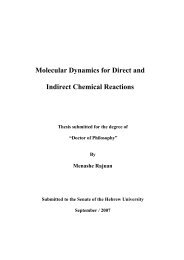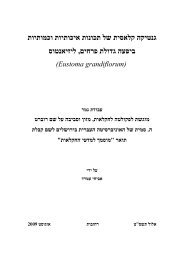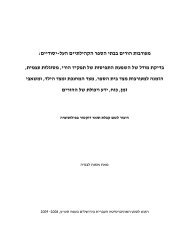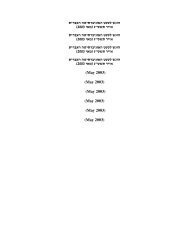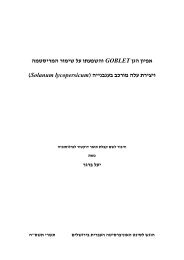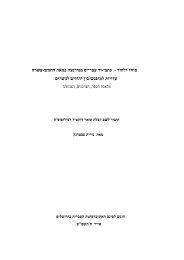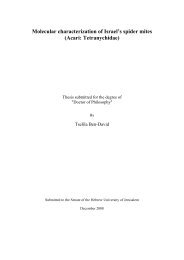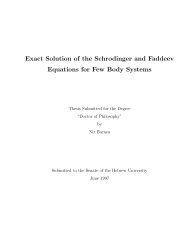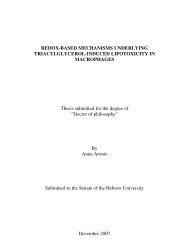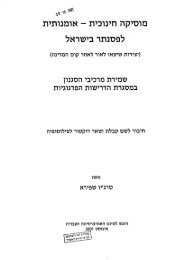Revealing the Mechanism of HSP104 Transcription Initiation in the ...
Revealing the Mechanism of HSP104 Transcription Initiation in the ...
Revealing the Mechanism of HSP104 Transcription Initiation in the ...
You also want an ePaper? Increase the reach of your titles
YUMPU automatically turns print PDFs into web optimized ePapers that Google loves.
71. Kuras, L., P. Kosa, M. Mencia, and K. Struhl. 2000. TAF-Conta<strong>in</strong><strong>in</strong>g and<br />
TAF-<strong>in</strong>dependent forms <strong>of</strong> transcriptionally active TBP <strong>in</strong> vivo. Science<br />
288:1244-8.<br />
72. Kuras, L., and K. Struhl. 1999. B<strong>in</strong>d<strong>in</strong>g <strong>of</strong> TBP to promoters <strong>in</strong> vivo is<br />
stimulated by activators and requires Pol II holoenzyme. Nature 399:609-13.<br />
73. Kurdistani, S. K., and M. Grunste<strong>in</strong>. 2003. Histone acetylation and<br />
deacetylation <strong>in</strong> yeast. Nat Rev Mol Cell Biol 4:276-84.<br />
74. Lallet, S., H. Garreau, C. Garmendia-Torres, D. Szestakowska, E. Boy-<br />
Marcotte, S. Quevillon-Cheruel, and M. Jacquet. 2006. Role <strong>of</strong> Gal11, a<br />
component <strong>of</strong> <strong>the</strong> RNA polymerase II mediator <strong>in</strong> stress-<strong>in</strong>duced<br />
hyperphosphorylation <strong>of</strong> Msn2 <strong>in</strong> Saccharomyces cerevisiae. Mol Microbiol<br />
62:438-52.<br />
75. Lallet, S., H. Garreau, C. Poisier, E. Boy-Marcotte, and M. Jacquet. 2004.<br />
Heat shock-<strong>in</strong>duced degradation <strong>of</strong> Msn2p, a Saccharomyces cerevisiae<br />
transcription factor, occurs <strong>in</strong> <strong>the</strong> nucleus. Mol Genet Genomics 272:353-62.<br />
76. Lee, J., A. Romeo, and D. J. Kosman. 1996. <strong>Transcription</strong>al remodel<strong>in</strong>g and<br />
G1 arrest <strong>in</strong> dioxygen stress <strong>in</strong> Saccharomyces cerevisiae. J Biol Chem<br />
271:24885-93.<br />
77. Lee, S., T. Carlson, N. Christian, K. Lea, J. Kedzie, J. P. Reilly, and J. J.<br />
Bonner. 2000. The yeast heat shock transcription factor changes conformation<br />
<strong>in</strong> response to superoxide and temperature. Mol Biol Cell 11:1753-64.<br />
78. Lemon, B., and R. Tjian. 2000. Orchestrated response: a symphony <strong>of</strong><br />
transcription factors for gene control. Genes Dev 14:2551-69.<br />
79. Li, B., M. Carey, and J. L. Workman. 2007. The role <strong>of</strong> chromat<strong>in</strong> dur<strong>in</strong>g<br />
transcription. Cell 128:707-19.<br />
80. Li, X. Y., A. Virbasius, X. Zhu, and M. R. Green. 1999. Enhancement <strong>of</strong> TBP<br />
b<strong>in</strong>d<strong>in</strong>g by activators and general transcription factors. Nature 399:605-9.<br />
81. L<strong>in</strong>dquist, S. 1986. The heat-shock response. Annu Rev Biochem 55:1151-91.<br />
82. L<strong>in</strong>dquist, S., and E. A. Craig. 1988. The heat-shock prote<strong>in</strong>s. Annu Rev<br />
Genet 22:631-77.<br />
83. Liu, X. D., and D. J. Thiele. 1996. Oxidative stress <strong>in</strong>duced heat shock factor<br />
phosphorylation and HSF-dependent activation <strong>of</strong> yeast metallothione<strong>in</strong> gene<br />
transcription. Genes Dev 10:592-603.<br />
84. Lucch<strong>in</strong>i, G., A. G. H<strong>in</strong>nebusch, C. Chen, and G. R. F<strong>in</strong>k. 1984. Positive<br />
regulatory <strong>in</strong>teractions <strong>of</strong> <strong>the</strong> HIS4 gene <strong>of</strong> Saccharomyces cerevisiae. Mol<br />
Cell Biol 4:1326-33.<br />
85. Mager, W. H., and A. J. De Kruijff. 1995. Stress-<strong>in</strong>duced transcriptional<br />
activation. Microbiol Rev 59:506-31.<br />
86. Marchler, G., C. Schuller, G. Adam, and H. Ruis. 1993. A Saccharomyces<br />
cerevisiae UAS element controlled by prote<strong>in</strong> k<strong>in</strong>ase A activates transcription<br />
<strong>in</strong> response to a variety <strong>of</strong> stress conditions. Embo J 12:1997-2003.<br />
87. Mart<strong>in</strong>ez-Pastor, M. T., G. Marchler, C. Schuller, A. Marchler-Bauer, H. Ruis,<br />
and F. Estruch. 1996. The Saccharomyces cerevisiae z<strong>in</strong>c f<strong>in</strong>ger prote<strong>in</strong>s<br />
Msn2p and Msn4p are required for transcriptional <strong>in</strong>duction through <strong>the</strong> stress<br />
response element (STRE). Embo J 15:2227-35.<br />
88. M<strong>in</strong>ehart, P. L., and B. Magasanik. 1991. Sequence and expression <strong>of</strong> GLN3,<br />
a positive nitrogen regulatory gene <strong>of</strong> Saccharomyces cerevisiae encod<strong>in</strong>g a<br />
prote<strong>in</strong> with a putative z<strong>in</strong>c f<strong>in</strong>ger DNA-b<strong>in</strong>d<strong>in</strong>g doma<strong>in</strong>. Mol Cell Biol<br />
11:6216-28.<br />
57



